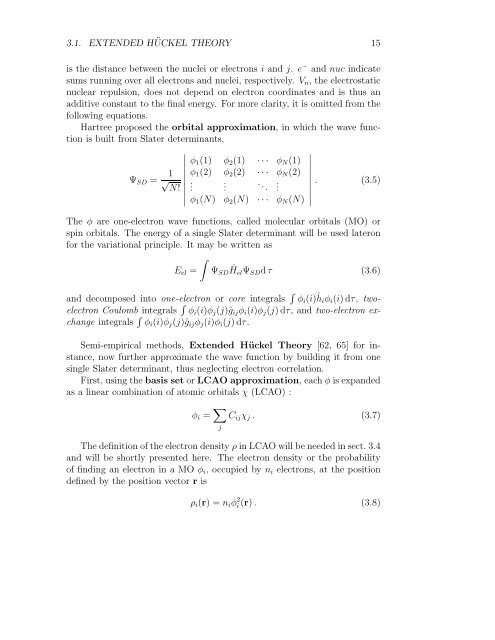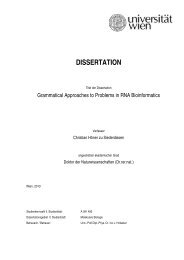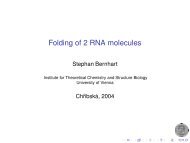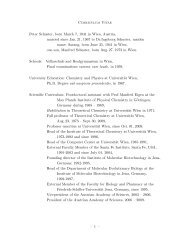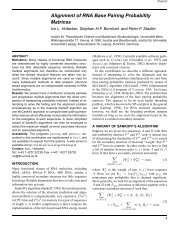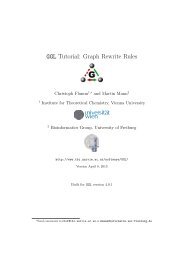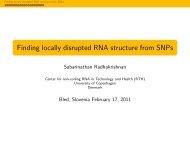A Toy Model of Chemical Reaction Networks - TBI - Universität Wien
A Toy Model of Chemical Reaction Networks - TBI - Universität Wien
A Toy Model of Chemical Reaction Networks - TBI - Universität Wien
You also want an ePaper? Increase the reach of your titles
YUMPU automatically turns print PDFs into web optimized ePapers that Google loves.
3.1. EXTENDED HÜCKEL THEORY 15<br />
is the distance between the nuclei or electrons i and j. e − and nuc indicate<br />
sums running over all electrons and nuclei, respectively. V n , the electrostatic<br />
nuclear repulsion, does not depend on electron coordinates and is thus an<br />
additive constant to the final energy. For more clarity, it is omitted from the<br />
following equations.<br />
Hartree proposed the orbital approximation, in which the wave function<br />
is built from Slater determinants,<br />
∣ ∣∣∣∣∣∣∣∣ φ 1 (1) φ 2 (1) · · · φ N (1)<br />
Ψ SD = √ 1 φ 1 (2) φ 2 (2) · · · φ N (2)<br />
. N! . . .. . (3.5)<br />
.<br />
φ 1 (N) φ 2 (N) · · · φ N (N) ∣<br />
The φ are one-electron wave functions, called molecular orbitals (MO) or<br />
spin orbitals. The energy <strong>of</strong> a single Slater determinant will be used lateron<br />
for the variational principle. It may be written as<br />
∫<br />
E el = Ψ SD Ĥ el Ψ SD d τ (3.6)<br />
and decomposed into one-electron or core integrals ∫ φ i (i)ĥiφ i (i) dτ, twoelectron<br />
Coulomb integrals ∫ φ i (i)φ j (j)ĝ ij φ i (i)φ j (j) dτ, and two-electron exchange<br />
integrals ∫ φ i (i)φ j (j)ĝ ij φ j (i)φ i (j) dτ.<br />
Semi-empirical methods, Extended Hückel Theory [62, 65] for instance,<br />
now further approximate the wave function by building it from one<br />
single Slater determinant, thus neglecting electron correlation.<br />
First, using the basis set or LCAO approximation, each φ is expanded<br />
as a linear combination <strong>of</strong> atomic orbitals χ (LCAO) :<br />
φ i = ∑ j<br />
C ij χ j . (3.7)<br />
The definition <strong>of</strong> the electron density ρ in LCAO will be needed in sect. 3.4<br />
and will be shortly presented here. The electron density or the probability<br />
<strong>of</strong> finding an electron in a MO φ i , occupied by n i electrons, at the position<br />
defined by the position vector r is<br />
ρ i (r) = n i φ 2 i (r) . (3.8)


